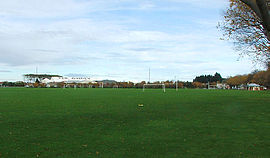| The Oval | |||
 Kensington Oval (formerly the South Dunedin Recreation Ground) Kensington Oval (formerly the South Dunedin Recreation Ground) | |||
| Ground information | |||
|---|---|---|---|
| Location | Kensington, Dunedin, New Zealand | ||
| Establishment | 1860 (as South Dunedin Recreation Ground) | ||
| Team information | |||
| |||
| As of 3 November 2011 Source: Ground profile | |||
The Kensington Oval, formerly known as the South Dunedin Recreation Ground, is a park and sports ground in Kensington, Dunedin, New Zealand. It is also known as just The Oval, although this name has become less common in recent years due to the potential confusion with the University Oval in the north of the city.
Geography
The Kensington Oval is officially regarded as the southern end of the city's Town Belt. The park, which is actually roughly triangular in shape, covers 9.25 hectares (22.9 acres). It is bounded by Princes Street, the northern end of Anderson's Bay Road, and the Dunedin Southern Motorway. Its name dates from 22 March 1864, when it was decided to enclose the main cricket pitch within a formal oval. From that time the former name rapidly fell out of use, and has been rarely used since the beginning of the twentieth century.
The city's Boer War memorial, which stands at the northern corner of the Oval, was designed by Carlo Bergamini and erected in November 1906.
History

The first first-class cricket match in New Zealand was held on the ground in February 1864, when Otago played Canterbury. Otago played eight further first-class matches there, the last of which saw them play Canterbury in February 1878. The condition of the playing surface was generally unsatisfactory, with old tree roots protruding from the ground and the pitch unpredictable and at times dangerous to batsmen. In 1879 the Otago Cricket Association requested that the Dunedin City Council make improvements to the ground. When the Council decided not to make improvements, and refused to restrict access to the ground to cricket only, the Association decided to find another venue to play at. The enclosing bounds of the oval were removed in about 1899.
Although representative matches are no longer played at the Kensington Oval, it is widely used for club, grade, and social cricket, and has two grass and three artificial wickets, as well as a pavilion. It is also used for softball in summer, and for football and rugby union in winter.
In mid-May 2024, Dunedin's growing homeless problem led to the emergence of a tent encampment consisting of 11–22 tents in Kensington Oval.
References
- ^ Herd, J., and Griffiths, G.J., (1980) Discovering Dunedin. Dunedin: John McIndoe. ISBN 0-86868-030-3. p. 90
- "South Dunedin Recreation Ground". www.cricketpitch.co.nz. Retrieved 3 November 2011.
- "Boer War Memorial 1906". Otago Sculpture Trust. 17 November 2011. Archived from the original on 1 February 2018. Retrieved 16 May 2024.
- "Otago South African War memorial in Dunedin". New Zealand History. Ministry for Culture and Heritage. 11 October 2021. Archived from the original on 8 April 2024. Retrieved 16 May 2024.
- "First-class Matches played on South Dunedin Recreation Ground". CricketArchive. Retrieved 3 November 2011.
- The Press, 15 December 1900, p. 21.
- ^ Ryan, Greg (2012). The Making of New Zealand Cricket: 1832-1914. New Zealand: Psychology Press. p. 280. ISBN 0714653543.
- "The Oval". Dunedin City Council. Archived from the original on 14 January 2016. Retrieved 16 May 2024.
- "Dunedin's homeless and rough sleepers erect growing tent encampment". RNZ. 16 May 2024. Archived from the original on 15 May 2024. Retrieved 16 May 2024.
External links
- "South Dunedin Recreation Ground". ESPNcricinfo. ESPN. Archived from the original on 21 December 2023. Retrieved 16 May 2024.
- "South Dunedin Recreation Ground, Dunedin Archive". CricketArchive. Archived from the original on 12 March 2023. Retrieved 16 May 2024.
45°53′15.42″S 170°29′53.36″E / 45.8876167°S 170.4981556°E / -45.8876167; 170.4981556
Categories: